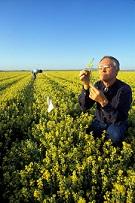

The solutions involve many branches of technical and scientific study, but many significant gains have been and will be made by agricultural and biological engineers. Gazing from the windshield in many rural areas, one notices the most obvious development is the increased size of agricultural field equipment. Faster, higher-horsepower equipment has been developed to increase the productivity of the farmer, but many technological advances are behind the scenes are also important in the bigger picture.
To many of us, the GPS app on our phone helps us find our way while traveling. Agriculture takes this to a whole new level and guides the variable placement of seeds, nutrients, water and plant protective materials. Precision placement decreases the input costs and ultimately increases the rate of return for these inputs. Technology can guide the equipment through the field with ever-decreasing driver input. This allows the equipment operator to multitask and put in long hours with less fatigue. Ultimately, the future may hold completely autonomous equipment.
Technological improvements go far beyond the field equipment. Applications for unmanned aerial systems abound in agriculture and food production. From scouting fields to inspecting the exterior perimeter of grain silos, these devices have opened new options. As the ability to gather data has improved, so has the way in which the data is processed and used. Properly utilizing data helps in making the best-possible decisions for an operation on an ongoing basis.
One of the core objectives with the pursuit of improved technology on the farm is to reduce the labor it takes to produce and process food. Just as the corn farmer of yore hand-picked each ear, the dairy farmer hand-milked each cow. Much change has occurred on the dairy as well over the decades and robotic milking systems are now becoming more common. Each cow can be identified by an RFID tag that communicates the amount of feed the animal gets and other important data as she enters the milking parlor. Today’s modern dairy is a far cry from a small stool and a stainless steel bucket.
Even in labor-intensive sectors like greenhouse production, efficiency strides are being made to improve productivity through better utilization of inputs and ergonomic design that improves repetitive tasks. One example, LED lighting, is an area of current research that has long-term cost reduction benefits and was not financially available just a few years ago.
All of this progress does not eliminate the need for sustainability. The soil is a farm’s most valuable resource and preserving the fertility of that soil is key to the future of an operation. Farmers have a variety of tools to prevent nutrient run off and soil erosion. These range from working with the natural contours of the fields to direct and capture water with grass waterways, terraces and filter strips to tillage methods suited to the topography and soil types. While still used in some instances, the traditional moldboard plow has been replaced by reduced tillage or no-till methods. The farmer can select the amount of tillage needed to achieve the desired residue covering the surface of the field. Concerns about drought and aquifer drawdown are also driving innovation, especially in irrigation technology and practices.

All of this progress ultimately relies on people to make it happen. The average farmer in the U.S. is 57 years old, and Canada has similar demographics. Peak graduation for many engineering disciplines occurred in the mid-1980s, and many practicing engineers are nearing retirement. These trends spell opportunity for many who are interested in pursuing engineering careers in agriculture and natural resource management.
Part of the push toward more efficient equipment and greater automation is also workforce related. In many parts of the U.S., there are notable shortages of farm labor. The law of supply and demand dictates that those workers willing to do these tasks can command higher wages and be more selective in the farm operations where they choose to work. Application of technology not only reduces the drudgery of many tasks, but equipment operators usually earn a higher wage than manual laborers.
There are positive labor trends, however, on the horizon, with millennials showing a strong interest in pursuing careers in agriculture. Many have little or no prior experience in production agriculture and unlike like prior generations, millennials are anticipated to be the first generation to retire from farming. Some are attracted to the fast-developing area of urban and controlled environment agriculture. Currently, these production methods account for only a small percentage of overall food production, but are growing.
Also, biological and agricultural engineers will contribute significantly to the growth of controlled environment agriculture or growing indoors. They will help answer producers’ questions, such as: how much water should I use? Can I use reclaimed or gray water? What are the ideal growing conditions? What nutrients does the crop need? Should I grow in soil or another medium? Is it better to pursue an organic path or something else?
There are so many more topics that could be included or expanded in this short article: autonomous vehicles, aquaculture, worker protection, precision irrigation. Add to the list the need to develop solutions that are appropriate to the setting: technology and practices that are successful in so-called developed countries cannot always be directly transferred for use in other parts of the world.

There is no shortage of challenges, in either the short or the long term, to providing food, fiber, timber and fuel for our growing world population. Fortunately, many bright minds are working hard to develop solutions to ensure we all have plentiful, affordable food in the future.
Members of the American Society of Agricultural and Biological Engineers (ASABE) are leading the innovation curve in all of this work. Founded in 1907, ASABE has members in more than 100 countries. About half work in industry; others work in public service, including federal agencies and academia. Most members hold degrees in agricultural or biological engineering, a distinct engineering discipline with a curriculum that combines the study of engineering principles with biological sciences.

